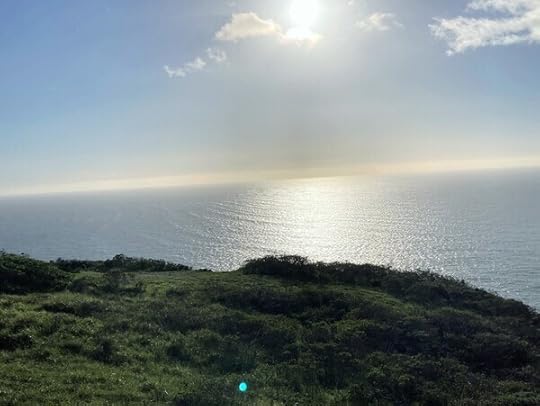Marc Lesser's Blog, page 14
January 27, 2022
Try Stuff
Apparently it was Voltaire in the late 1700’s who said “perfect is the enemy of good.”
I experience this often in my writing and can sometimes find it debilitating when I need to produce “book-worthy” writing. I remember once feeling completely stuck while working on a writing project. I decided to sign up for a writing workshop where we just wrote for 12 minutes at a time, responding to a variety of prompts. I remember some of my favorite writing prompts:
– what surprises me about my life right now….
– my father’s desk…
– that night in the hotel….
Writing in this way, without judging and criticizing, was freeing. It allowed me to express myself with more openness and vulnerability, and to produce much more satisfying results.
There is a story about a ceramics teacher who announced during the first class that half of the class would be graded for the semester based on quality – they only needed to produce one great piece. The other half of the class would be graded solely on quantity and fifty pounds of pots would result in an A.
At the end of the semester the works of the highest quality were all produced by the quantity group. They had tried things and learned from their mistakes whereas the quality group had been stymied by their quest for perfection.
I’ve discovered that this is the only way I can learn – to try things, to make mistakes, to at times look completely foolish, to learn and grow.
Of course, we all want success. We yearn for perfection. It’s not about lowering our standards or accepting sloppiness.
Aim high, and explore, experiment, try stuff. See what happens.
P.S. If writing is your thing, then try these writing prompts to help overcome the dreaded “blank page.”
Enjoy Reading This Post?
If you enjoyed this post, please consider sharing it with others via: Facebook, Twitter, LinkedIn, or email.
For more posts like this, you can subscribe to my newsletter. It’s free, I will never share your email address, and you can unsubscribe anytime.
The post Try Stuff appeared first on Marc Lesser.
January 13, 2022
Finding Integration within Chaos and Rigidity
Right now, are you feeling energized and alert? Are you feeling comfortable and relaxed? Experiment and see if you can be energized and comfortable at the same time.
Athletes are great models for this quality of being. I love (and try to learn from) watching Steph Curry dribbling, weaving and bobbing, then shooting a basketball – part juggler, athlete, and magician, so completely modeling being totally relaxed and totally alert at the same time.
Often when I’m leading guided meditations I emphasize the intention and aspiration to find a way to be relaxed and alert – an important and effective approach and way of skillfully entering leadership, work, and our relationships. To relax, I suggest relaxing the shoulders, let go of any holding in the face or jaw, and soften the belly. To bring more energy, try sitting up a bit more, perhaps arching the back slightly. Notice how you hold or place your hands and feet and your entire body — sitting or standing more consciously.
Whether it’s the stresses and challenges of covid, of our work, and the various challenges of being human, a state that includes both more alertness and relaxation can help.
I was once co-teaching a mindful leadership training with Dr. Dan Siegel, a psychiatrist, author, teacher, and friend. I was struck when he said that all psychological challenges fall into one of two categories: too much chaos or too much rigidity. Chaos is a lack of order and control, not holding on tightly enough. Rigidity is holding on too tightly; too much order and control.
Dan went on to say that mindfulness practice and physical and emotional well-being can be described as integration. Sometimes we need some chaos. In some way chaos can be seen as an extension of energy, lots of letting go. Sometimes we need rigidity, holding on tight. We need more clarity, and more order. The “sweet spot” is integration — knowing when we need chaos, when we need rigidity, and not being too caught by either end of the spectrum.
As a leader, and in all our relationships, it can be challenging to find the sweet spot, of integration between or the most effective mix and balance of chaos and rigidity. How do we respond to covid – what is the right balance of rigidity and chaos? How do we make decisions? How much to do ourselves, or find support or to delegate? How much structure or lack of structure to provide for your team, work, or family?
A useful place to meet these questions, and find greater integration of chaos and rigidity is to practice — in meditation, work, basketball or any activity — starting with the body, intentionally practicing with being alert and relaxed, relaxed and alert.
The post Finding Integration within Chaos and Rigidity appeared first on Marc Lesser.
December 22, 2021
Bring What You Have
I love the surprising and timely ways in which ancient Zen teachings, modern poetry, and our lives intersect, inform, and most of all point the way to greater appreciation for being alive.
A core Zen teaching or “koan” (and the second of 100 teachings from an 11th century Chinese collection known as The Blue Cliff Record) is:
The Ultimate Path is without difficulty
Just Avoid picking and choosing.
Just don’t love or hate,
And you’ll be lucid and clear.
I’m feeling particularly reflective and curious as 2021 comes to a close. Of course, I’m picking and choosing as I consider this past year and the year to come. These reflections are contextualized by just over two years of living in a global pandemic, with more than 800,000 deaths here in the U.S alone. If these words seem mysterious and impossible, perhaps that’s the point. Our lives are mysterious and impossible. So much to love. So much to hate. And yet, so much to appreciate beyond loving and hating.
What is this practice of not picking and choosing? How might we work with these oblique instructions?
A poem by David Whyte helps me in working with and penetrating these words. The poem is about Camino de Santiago, a sacred journey in Spain. It’s called: For The Road To Santiago:
For the road to Santiago, don’t make new declarations about what to bring and what to leave behind.
Bring what you have.
You were always going that way anyway,
you were always
going there all along.
From Still Possible
The opening of the poem, to me, says not to pick and choose. Instead, notice what I have. Notice who I am. Notice that we are alive, here, now.
“Bring what you have” encourages me to appreciate everything. It’s like starting over, letting go of my usual narratives, my usual stories about my failures and successes, and seeing what emerges fresh, new, and unknown.
“You were always going that way anyway” says to me: let go, trust, take a look at your life from a larger vantage point. See the threads and connections of our deepest sense of our lives that don’t change, that carry us from birth until death.
Right now, see what you have. Let go of picking and choosing. Bring what you have. From this place, what’s next? What do you have to appreciate and what do you have to offer?
Wishing us all a New Year of light, love, and appreciation.
Here are a couple of photos from a recent walk in the Marin Headlands.
The post Bring What You Have appeared first on Marc Lesser.
December 16, 2021
Why I Love Meditation Retreats
A long-term meditation retreat is a radical act of self-care and self-healing, a radical act of self-discovery (and going beyond the self), and radical act of sanity. Most of all it’s a radical act of love.
I just completed a 7-day retreat. I aspire to do one of these each year. It is one of the more challenging and rewarding parts of my life. It is somewhat of an ordeal, like climbing a mountain or running a marathon, but different. Sore knees, stiff back, lots of boredom, tears of grief, and tears of joy. The schedule is primarily thirty-minute periods of meditation followed by ten minutes of walking meditation. There is some time for rest, work, and exercise and a talk by the retreat leader each day.
Here are some of the key reasons I appreciate and continue to return to these retreats:
Self-care and Self-healing. I sometimes compare the healing powers of meditation to the healing powers of sleep. There is tremendous evidence that while we sleep our bodies are undergoing fundamental repairs. And there is growing evidence that meditation plays a similar function, particularly in relation to our emotional centers. Experientially, long retreats allow me to take a serious pause from the demands of work, relationships, and technology – and sit in the middle of my life, with nothing to accomplish. It’s a way to take care of myself with every breath, with every period of meditation.
Self-discovery (and going beyond the self). Retreat for me is a way to completely remove all the usual daily distractions and just be quiet and simply bring attention to the body, breath, and mind – again and again, and just see what happens. My intention is to stay with all of the discomfort and pain and regrets, the appreciations and possibilities. It’s a way to explore what there is to learn, what patterns need to be dropped, what new ways of being are possible.
During my recent 7-day retreat, it was healing to reflect on my relationship with my parents who passed away many years ago. With lengthy retreats, there’s a way in which I become sick of myself. The usual channels and patterns of thought become too difficult to maintain, and something new opens up. My identification with the usual “self” lessens and at times melts away and something unexpected and surprising arises.
Radical Sanity to me is the practice of not doing harm, not being involved with politics, work, the pandemic, or checking my phone, emails, or texts. Nothing but putting my mind and body on the line. Just opening my heart. It’s an expression of care, a desire to explore, a way of being fully alive and sane.
Radical Act Of Love. My experience is that if I sit long enough the usual concerns, patterns, and identification with self loosens, and at times drops away. What’s left? Love. Throughout retreats I experience a feeling of gratefulness for being alive, for all of the gifts of relationships. The trees and flowers and stars look amazing. I feel lighter. Laughter comes easily. I feel deeply connected to myself, to my relationships, and to life.
I understand that to take time away from work and family can seem daunting or impossible. It helps to see this time as a “sharpening of the saw” — a way to renew, reset and refresh that can help you be more available for your family, work, and your life. I get that it’s a privilege that not everyone can do, but if you can, try it. See what happens. Start with a half-day, daylong, or go right for a 7-day retreat. For me, the trick is to put it on my calendar, well in advance. I’m often surprised how much support I feel from my work and family to take this time away.
Some resources for retreats:
Esalen
Garrison Institute
Hollyhock (BC, Canada)
Kripalu (for yoga enthusiasts)
San Francisco Zen Center
Spirit Rock Meditation Center
…. and there are many more!
Next best to a retreat, and a good preparation for one, is to work on developing or deepening a personal meditation practice. If you’re determined to make 2022 the year you take your meditation practice to the next level, then I invite you to join me in a 3-month practice period: Zen Wisdom for Modern Times. We’ll meet every Wednesday, starting January 5th for 90 minutes of meditation, teaching, and group discussion, and everyone is welcome, from beginners to those of you with a lifetime of meditation experience. Learn more here.
Some pics from Tassajara.
The post Why I Love Meditation Retreats appeared first on Marc Lesser.
November 28, 2021
What Do You Want?
I’m feeling grateful today, remembering Harry Roberts, one of my most important and influential mentors. We met when I was a 26-year-old Zen student, living at the San Francisco Zen Center’s Green Gulch Farm in Marin County. Harry was trained as a Yurok Indian shaman and had a deep knowledge and appreciation of California land and wildlife.
Harry often spoke of The Pinnacles. Last Friday morning I visited The Pinnacles National Park for the first time – something I’ve wanted to do for more than 40 years. Here are a few photographs I took. On the National Park Foundation website, the Pinnacles are described like this:
Rising out of the chaparral-covered Gabilan Mountains, east of central California’s Salinas Valley, are the spectacular remains of an ancient volcano. Massive monoliths, spires, sheer-walled canyons and talus passages define millions of years of erosion, faulting and tectonic plate movement. Within the park’s boundaries lie 26,000 acres of diverse wildlands. The park is renowned for the beauty and variety of its spring wildflowers. A rich diversity of wildlife can be observed throughout the year.
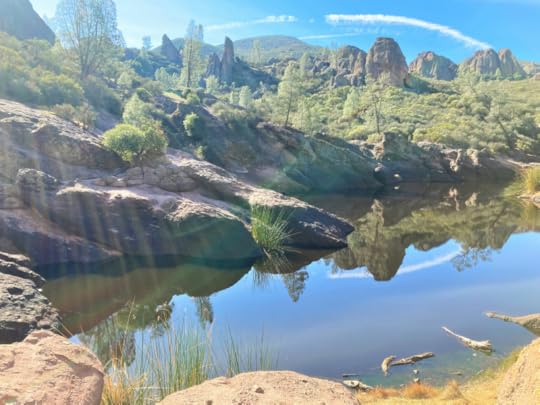
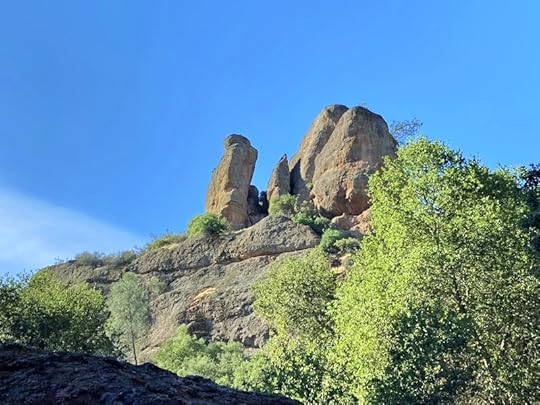
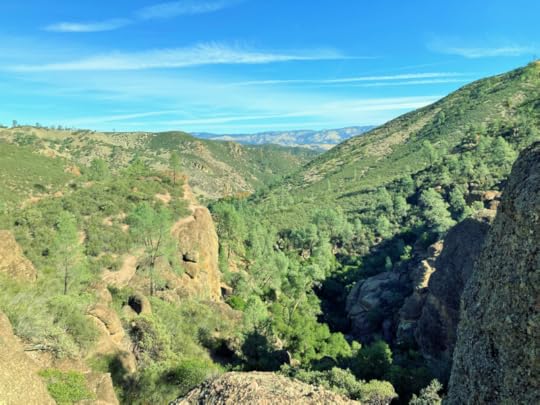
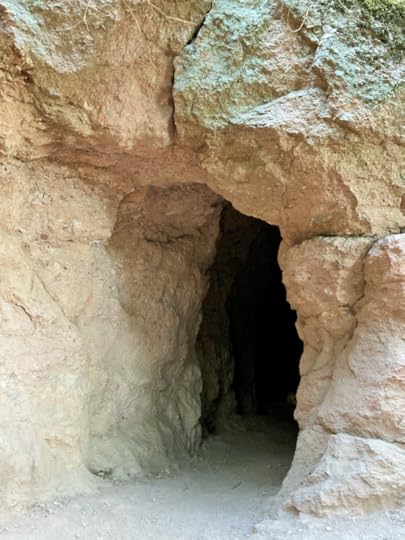
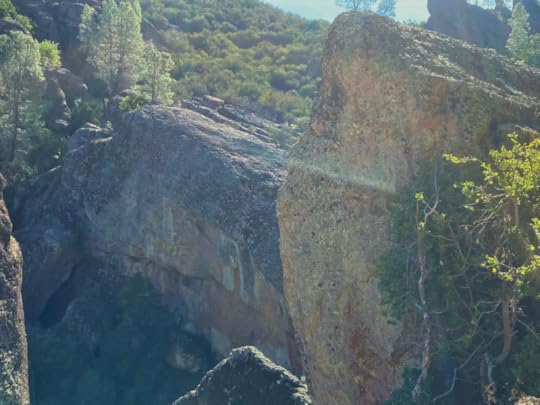
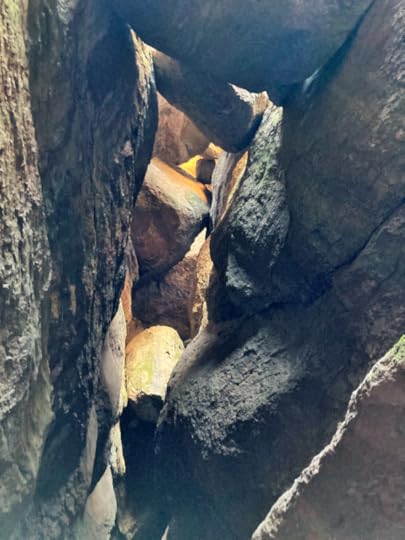
Harry’s health was declining when we met. I sometimes helped him with errands, driving him around in his yellow pickup truck. I learned a lot from the way in which he viewed the world – the birds, butterflies, and the rock formations. And I learned from how he related to objects like this truck. “Gently” Harry said as I applied the brakes going downhill on highway 1. “Use the brakes as little as possible. You want them to be in good shape when you need them.”
One of Harry’s most endearing and applicable teachings in the realm of appreciation is the importance of asking the simple question: What do you want? Harry would say that being human is simple. “Real simple” he would say, with a belly laugh. “So simple that most people neglect to ask and answer this question during their lifetimes.”
His follow-up questions were:
What do you have to do to get it?
Are you willing to pay the price?
I invite you to explore these three questions in your own life. They are an expression of deep appreciation for being alive.
The post What Do You Want? appeared first on Marc Lesser.
November 11, 2021
Be Curious. Not Furious
You’re driving when, suddenly, another car pulls in front of you. What do you do?
Or you’re feeling misunderstood, undervalued, disrespected, treated unfairly. How do you react?
It’s common and easy for us humans to respond to all of these situations by showing our anger or frustration. We seem to be wired to go directly from feeling hurt or threatened to indignation. Sometimes, all it takes is a few words or even just a glance and we get that feeling of an “ouch” which leads us to quickly and directly resort to blame and waspishness. Sometimes, we may even get furious. It all tends to happen so fast and automatically that we often don’t notice how rapidly our feelings turn into stories, or our stories turn into feelings, and then escalate into something much bigger.
It happens in families, in the workplace, on the street, and in relationships. These feelings and reactions perhaps help explain why an estimated 27 percent of Americans are estranged from members of their own family. Seen on a larger scale, this tendency to quickly resort to blame, anger, and fury is how wars begin and can go on for years, or even decades.
Here is one of my favorite quotes that describes some of the underlying reasons for why and how being hurt leads to anger and blame:
“We judge ourselves by our intentions: we judge others by the effects of their actions on us.”
Jack Himmelstein, Center for Understanding in Conflict
The first part of this quote implies that we all have a way of judging our intentions as good and worthy. We see ourselves as good people. We know that we mean well. We don’t intend to harm, create conflicts, or cause others’ pain.
However, when it comes to how we view others, especially when we feel hurt or let down by someone, we don’t automatically assume that they have our best interests in mind. We don’t tend to consider that their intentions are good or positive. Instead, we assume the worst. We create a story or narrative about their less-than-positive intentions. That is, we judge others by the effects of their actions on us.
So, how can we overcome this?
The answer lies in being curious instead of furious.
When you’re feeling hurt, instead of anger and blame, instead of assuming bad intentions, try to slow things down and bring curiosity to the situation. Your feelings are your feelings. Be curious about them, about whatever narrative you create, and about the other person’s intentions and motivations.
If you’re in your car and someone cuts you off on the highway, instead of immediately reacting with irritability and annoyance, try considering why they’re in such a hurry. Perhaps there is some kind of emergency? Reframing in this way can quickly dissolve feelings of resentment and even make room for compassion (I hope that person doesn’t continue to drive recklessly like that; they could get hurt.).
If someone says something that hurts your feelings, be curious about their intentions and motivations. All you know is that your feelings were hurt. You don’t know what their objective was when they said what they said.
Any time you notice feelings of anger arising, and any time you find yourself feeling misunderstood, undervalued, disrespected, or treated unfairly, be curious, not furious.
It’s an expression of freedom that can change you, your relationships, and the world.
The post Be Curious. Not Furious appeared first on Marc Lesser.
November 1, 2021
Widening Your Perspective In The Midst of Change
I often resist and don’t like change. I still grieve my children leaving home, and that was many years ago. I miss the companies I founded and the teams I created. I miss traveling and I’m tired of this pandemic. I look in the mirror and wonder what happened to the 35-year old me. So much change. I sometimes joke that I’d like to start a support group called Buddhists Against Change. (This is a particularly unique and ironic support group, since embracing change and impermanence is a foundational Buddhist principle.)
We often resist change. Some neuroscience studies indicate that a lack of certainty registers in our brains in our pain centers. Thus, in some very gross ways, change equals pain. It often feels that way to me.
Regina Pally is a neuroscientist who wrote a paper called The Predicting Brain. In it she states:
“Even before events happen, the brain has already made a prediction … and sets in motion the perception, behaviors, emotions, psychological responses, and interpersonal ways of relating that best fit with what is predicted. … We learn from the past what to predict for the future and then live the future we expect.”
That is, we expect the world to stay the same, or at least to be predictable. It’s not. In truth, in reality, nothing stays the same. This moment, this now, is different than the now when I began writing the sentence. Our bodies, minds, and emotions are constantly changing.
Of course, our ability to attempt to predict the future is essential – in running our businesses and in running our lives. When we walk toward a door, our hand expects and knows where the door knob is; our feet expect the floor to be where we place them. We look at sales and expense patterns and count on the predictions we make. We love predicting the future. We resist change.
So, what about when the unexpected happens – like a fire, or a pandemic, like being hired or fired, like any unexpected or unplanned gains, losses, or interruptions?
What about our children growing up, loss, old age, sickness, and death? This is where not only Buddhism, but most religions start – facing change, engaging with a dynamic, unpredictable body, mind, relationships, work, and universe.
What are some effective practices and strategies for working with change?
Meditation could be described as the practice of shifting our relationship with change. It’s the practice of living more in reality, lessening our predictions, and opening to whatever happens. Shunryu Suzuki suggests that when we exhale, we do not predict that it will be followed by another inhale. It’s a way of completely giving up, completely accepting that we don’t know what will happen, and to become more and more comfortable with this reality.
This is a simple and profound practice. With each breath, not knowing, letting go of what will happen next, and training ourselves to not resist, not run away, not be afraid of not knowing.
Our lives these days, with the pandemic, with climate change, with the constant changes brings up the image for me that each of us is in a small boat in a large and turbulent ocean. It feels dangerous and unpredictable. Someone needs to stay calm and focused — calm in the midst of the turbulence, and focused on finding solutions. And one calm and focused person can be contagious, can help everyone on the boat to be more calm and more focused.
I find this image immensely and immediately useful in work, in leadership, in all our relationships in life — being in a small boat in a turbulent sea.
Let’s all practice with a healthy relationship with change. More acceptance, less resistance, less predicting everything will stay the same. Less blaming and railing against change, against what is. Let’s all work to be that calm and focused person in the boat, navigating turbulent waters.
And, let’s explore a practice, to help you to shift your relationship with change.
The practice is: NOW Notice. Own. Widen Your Perspective
Notice the change. Notice that everything changes, moment to moment.
Own the changes. Let go of resisting or pretending that things stay the same. Let go of blaming the situation for changing or being difficult or challenging. Let go of blaming other people. This can be a really difficult one. Try on owning what your contribution is to whatever situation you find yourself in. It’s not your fault, and it is your responsibility.
Widen your perspective. See yourself, others, the world as though you are looking in from a distance. In this way you can accept and even celebrate change and how change makes everything more valuable, more precious. Appreciate each moment. This moment. Now this moment.
The post Widening Your Perspective In The Midst of Change appeared first on Marc Lesser.
October 27, 2021
Buddhists Against Change
I often resist and don’t like change. I still grieve for my children leaving home, and that was many years ago. I miss the companies I founded and the teams I created. I miss traveling and I’m tired of this pandemic. I look in the mirror and wonder what happened to the 35-year old me. So much change. I sometimes joke that I’d like to start a support group called Buddhists Against Change. (This is a particularly unique and ironic support group, since embracing change and impermanence is a foundational Buddhist principle.)
We often resist change. Some neuroscience studies indicate that a lack of certainty registers in our brains in our pain centers. Thus, in some very gross ways, change equals pain. It often feels that way to me.
Regina Pally is a neuroscientist who wrote a paper called The Predicting Brain. In it she states:
“Even before events happen, the brain has already made a prediction … and sets in motion the perception, behaviors, emotions, psychological responses, and interpersonal ways of relating that best fit with what is predicted. … We learn from the past what to predict for the future and then live the future we expect.”
That is, we expect the world to stay the same, or at least to be predictable. It’s not. In truth, in reality, nothing stays the same. This moment, this now, is different than the now when I began writing the sentence. Our bodies, minds, and emotions are constantly changing.
Of course, our ability to attempt to predict the future is essential – in running our businesses and in running our lives. When we walk toward a door, our hand expects and knows where the door knob is; our feet expect the floor to be where we place them. We look at sales and expense patterns and count on the predictions we make. We love predicting the future. We resist change.
So, what about when the unexpected happens – like a fire, or a pandemic, like being hired or fired, like any unexpected or unplanned gains, losses, or interruptions?
What about our children growing up, loss, old age, sickness, and death? This is where not only Buddhism, but most religions start – facing change, engaging with a dynamic, unpredictable body, mind, relationships, work, and universe.
What are some effective practices and strategies for working with change?
Meditation could be described as the practice of shifting our relationship with change. It’s the practice of living more in reality, lessening our predictions, and opening to whatever happens. Shunryu Suzuki suggests that when we exhale, we do not predict that it will be followed by another inhale. It’s a way of completely giving up, completely accepting that we don’t know what will happen, and to become more and more comfortable with this reality.
This is a simple and profound practice. With each breath, not knowing, letting go of what will happen next, and training ourselves to not resist, not run away, not be afraid of not knowing.
Our lives these days, with the pandemic, with climate change, with the constant changes brings up the image for me that each of us is in a small boat in a large and turbulent ocean. It feels dangerous and unpredictable. Someone needs to stay calm and focused — calm in the midst of the turbulence, and focused on finding solutions. And one calm and focused person can be contagious, can help everyone on the boat to be more calm and more focused.
I find this image immensely and immediately useful in work, in leadership, in all our relationships in life — being in a small boat in a turbulent sea.
Let’s all practice with a healthy relationship with change. More acceptance, less resistance, less predicting everything will stay the same. Less blaming and railing against change, against what is. Let’s all work to be that calm and focused person in the boat, navigating turbulent waters.
And, let’s explore a practice, to help you to shift your relationship with change.
The practice is: NOW Notice. Own. Widen Your Perspective
Notice the change. Notice that everything changes, moment to moment.
Own the changes. Let go of resisting or pretending that things stay the same.
Widen your perspective. See yourself, others, the world as though you are looking in from a distance. In this way you can accept and even celebrate change and how change makes everything more valuable, more precious. Appreciate each moment. This moment. Now this moment.
The post Buddhists Against Change appeared first on Marc Lesser.
October 13, 2021
Do Good. Avoid Harm. Appreciate Your Lunacy. Pray For Help
I don’t think this directive needs much explanation or commentary. It is simple and clear. It’s obvious and outrageous. It’s intended to be serious and humorous at the same time. I think it’s exactly what we need during this time of living in an ongoing pandemic. And it’s what we need in our human lives of contending with change, stress, and disappointment. It can be successfully adopted and utilized in our personal lives or at work. I’ve used it in working with CEO’s and in my weekly Zen meditation group. I feel lighter practicing with this saying.
It is a formal slogan, intended to be reflected upon, practiced, and embodied as a way of life. It comes from an ancient Tibetan Buddhist practice of working with sayings or directives as a means of waking up, of transcending our usual narrow and egotistical viewpoints. (This particular translation comes from my friend Norman Fischer, from his book Training in Compassion.)
Here are a few ideas on how we might understand and work with this slogan.
Do Good. Avoid Harm – We all want this right? Easy, check. But not so fast. Doing good and avoiding harm is harder than it sounds at first. It means living and working within a framework of helping others instead of merely surviving, trying to make a living, or maximizing our own benefit. What are you doing to help or harm our environment? In what ways are you supporting others, at work and outside of work – to grow and to flourish?
Appreciate Your Lunacy – Great word, lunacy. It is intended to free us up from ideas of knowing, of having it all together. Instead, appreciate how much you don’t know, the mystery of consciousness and of our lives. There is a tremendous amount of lunacy in how we’ve designed the various systems and assumptions that impact our thinking and our daily lives. I often look at our cities, our institutions, the ways we’ve organized our work lives and personal lives and think – how did we ever create these? It can be a great relief to let go of trying to make sense of things.
Pray For Help – We all need help, whether we pray, or wish, or ask. I like to pray. It makes me stop and think, that in some way, meditation practice is a form of prayer. It’s a way of letting go, and seeing what happens, without knowing what will happen. And, if the word pray doesn’t work for you, you can substitute asking for help, or look for support.
Do Good. Avoid Harm. Appreciate Your Lunacy. Pray For Help – what else do you need?
The post Do Good. Avoid Harm. Appreciate Your Lunacy. Pray For Help appeared first on Marc Lesser.
September 30, 2021
How to Offer an Appropriate Response in Any Situation
There is a famous dialogue from the Zen tradition where the students ask the teacher:
“What is the teaching of a lifetime?”
The teacher replies: “An appropriate response.”
The intended lessons from these few lines were probably not aimed at the world of business and leadership but more and more, I’m seeing how broadly applicable this teaching and practice is for the work environment.
One aspect of mindful leadership involves learning to recognize when we’re “appropriately responding” versus inappropriately reacting.
Responding appropriately and skillfully may sound easy or obvious but it is both subtle and profound.
For example, when there is any kind of conflict or disagreement in the workplace, it is very common to react either passively or aggressively. Passive is a common way of avoiding conflict, of not responding, or perhaps under-responding. This generally does not turn out well, for anyone involved.
The other common reaction to conflict and difficulty is aggression or over-reacting. This often involves some form of blame, or a subtle or not so subtle form of attack. Again, this generally turns out badly.
So, what are some ways to respond appropriately to conflict and difficulty? A few that come to mind are:
Be Curious. Try asking for more information by asking questions like: “Can you say more…?” Inquire with curiosity (and not judgement) about someone’s motivation: “Can you tell me why you said that or did that?
Be Present. See if you can stay in the moment with your thoughts and feelings without automatically moving toward judgement or assessment. Be cautious about reaching quickly into the past or the future. Ask yourself: “What’s happening right now?”
Be Clear. Try to speak with as much clarity as possible. Imagine it’s as though every one of your words mattered. (Hint: they do.)
Be Direct. Explore what you are feeling and how this person’s words or actions have impacted you, then communicate that as directly as possible without sugar coating anything. There’s no need to pretend or avoid, or to go on the offensive.
Be Vulnerable. Any of the preceding responses can be forms of vulnerability; in particular being present and direct. Be real. Be human. Be open. Notice if blame comes up. Bring awareness to your common humanity. Notice if wanting to attack or retreat comes up. Use curiosity and presence as tools to get you closer to responding in a way that you’ll be proud of when you look back at the encounter.
To respond appropriately is more than just a strategy. It’s an expression of your heart, your connection, and your identity. It’s also the heart of practice. It’s training yourself to be aware enough, confident enough, and humble enough to not fall into the trap of under-reacting or over-reacting, not being either passive or aggressive.
And that feels like a pretty appropriate response no matter the situation.
The post How to Offer an Appropriate Response in Any Situation appeared first on Marc Lesser.


